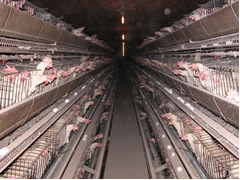Cruelty to Animals // Chickens
The Egg Industry
The 340 million chickens raised for their eggs, called “laying hens” by the industry, endure a nightmare that lasts for two years.22 A large portion of each hen’s beak is cut
off with a burning-hot blade, and no painkillers are used. Many birds, unable to eat
because of the pain, die from dehydration and weakened immune systems. After enduring
these mutilations, hens are shoved into tiny wire “battery” cages, which measure roughly
18 by 20 inches and hold five to 11 hens (McDonald’s, Burger King, Wendy’s, and Safeway
allow a maximum of five birds per cage), each of whom have a wingspan of 32 inches. Even
in the best scenario (five hens to a cage), each hen will spend the rest of her life crowded in a space about the size of a file drawer with four other hens, unable to lift
even a single wing.23
 |
Birds on egg farms don’t have enough space to lift one wing, and the wire grating of their cages constantly cuts into their feet. |
Battery cages are stacked on top of each other, and excrement constantly falls onto
the birds in the lower cages and into huge manure pits that line the sheds. The stench
of ammonia and feces hangs heavy in the air, and disease runs rampant in the filthy,
cramped sheds. Many birds die, and survivors are often forced to live with their dead
and dying cagemates, who are left to rot. The light in the sheds is constantly manipulated in order to maximize egg production. Periodically, for two weeks at a time, the hens are only fed reduced-calorie feed. This process induces an extra laying cycle.
Male chicks are worthless to the egg industry, so every year, millions of them are
tossed into trash bags to suffocate or are thrown into high-speed grinders called
macerators while they are still alive.24
After two years in these conditions, the hens’ bodies are exhausted, and their egg
production drops.
 |
This hen got caught under the feeding belt. She was left to die. |
These “spent” hens are shipped to slaughterhouses, where their fragile legs are snapped
into shackles and their throats are cut. By the time they are sent to slaughter, roughly 29 percent of the
hens are suffering from broken bones resulting from neglect and rough treatment.25 Their emaciated bodies are so damaged that
their flesh can generally be used only for chicken noodle soup, companion-animal food,
or “canned, boned, and diced” meat, much of which goes to the National School Lunch
Program (these purchases are in jeopardy, however, as students have been injured by
accidentally swallowing bone fragments).26
Eggs are horrible for your health. A single egg has as much cholesterol as three servings of beef tenderloin. (All vegan foods are cholesterol-free.) Many grocery-store eggs are infected with salmonella, a dangerous type of bacteria that causes diarrhea and fever in humans. |
Read more.
22 National Agricultural Statistics Service, “Chicken and Eggs,” 23 Oct. 2006.
23 Allison Schiff, “Fowl Call: Treat Egg-Laying Hens Humanely,” Twin-Boro News, 28 Jul. 2004.
24 Mench and Siegel.
25 Knowles and Wilkins.
26 Barbara Olejnik, “Dwindling Spent Hen Disposal Outlets Causes Concerns,” Poultry Times, 15 Sept. 2003.
|
















 Pilgrim’s Pride: KFC Slaughterhouse Exposé
Pilgrim’s Pride: KFC Slaughterhouse Exposé 45 Days in Hell: The Life and Death of a "Broiler" Chicken
45 Days in Hell: The Life and Death of a "Broiler" Chicken Silent Suffering: Egg Farm Investigation
Silent Suffering: Egg Farm Investigation Top 10 Reasons Not to Eat Chickens
Top 10 Reasons Not to Eat Chickens Pamela Anderson Speaks Out for Chickens
Pamela Anderson Speaks Out for Chickens If Your Cat Tasted Like Chicken, Would You Eat Her?
If Your Cat Tasted Like Chicken, Would You Eat Her?